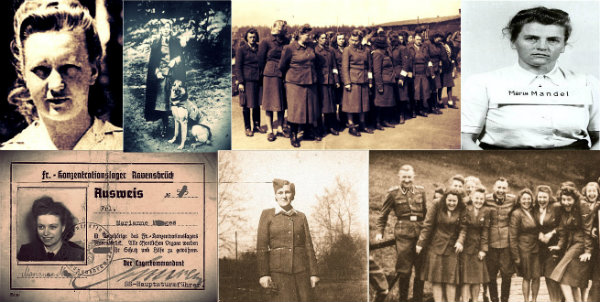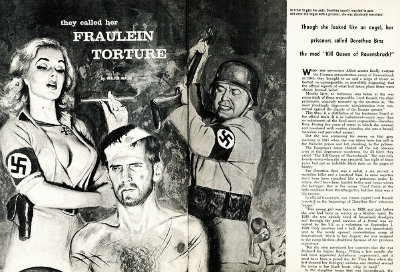Now that we know a fraction of the horrid things which went through the Nazis’ death camp for women, let us get to know the people behind these grisly atrocities — the camp’s female Nazi guards who were as evil as their male counterparts.
What Sort of Women were They?
Before Dorothea Binz, Ravensbruck’s SS supervisor during WWII, was executed, her last words were: “I hope you won’t think we were all evil people”.
The words she uttered before her death totally belie the actions she and the other female guards of the camp did while they were still alive and in authority — they were purely evil.
When Ravensbruck was liberated, it had been estimated that over 50,000 women were killed in it. The female prisoners of the camp also had to contend with the bloodcurdling treatments they received from those on the lookout for them, Ravensbruck’s female Nazi guards.
Reading through the previous article which showed us but a fraction of these horrid treatments, one question pops into mind: what kind of women were they that they were able to commit such terrible things to the others of their kind?
Usually, these female Nazi guards would be equated with their male counterparts and viewed as surrogate men. But, they were quite the contrary. The female nazi guards of Ravensbruck were every bit as female as any other female out there. they did not lack femininity but instead, enjoyed being feminine and even flaunted it.
Many of them were blond and, in their own way, beautiful. As a matter of fact, other girls from the nearby town of Furstenberg envied them. When not on duty, they enjoyed the usual wiles of the female kind — picking up flowers from the forest, going boating in the camp’s nearby lake, partying and even flirting with the several male SS guards assigned in the camp.
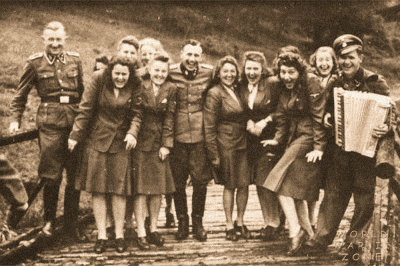
Ravensbruck even had its own hair salon where the female Nazi guards would go into and get themselves pampered by hairdressers from among the prisoners in the camp. They would get their hair done [the popular style of that time was the Olympia roll where the hair was swept back and up] all the while chatting and gossiping with each other just like any other woman would.
Then, like clothing, they would don on their snarling and screaming selves, bring out their whips and allow their dogs to go after and bite the camp’s inmates.
Knowing Ravensbruck’s Female Nazi Guards
There was about 3,500 female Nazi guards who worked inside Ravensbruck in all its six morbid years of existence. From these guards, their were some who went haunted by the evil barbarity that went within its walls.
There was Johanna Langefeld, Ravensbruck’s first head guard or Oberaufseherin as she was called. Johanna did not hesitate when it came to imposing callous punishments on the women prisoners of the camp. She could keep them standing in the cold and the rain for hours on end without the flick of an eye.
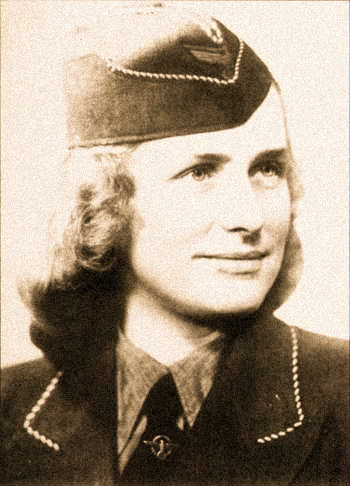
However, she drew the line at formal floggings and even was horrified by the vivisection medical trials done on the camp’s “rabbits”. Her secretary, an inmate, recounted how she got depressed, divided over what was right and wrong and even had horrible nightmares at night.
Johanna eventually lost her position as she was deemed soft during a near-mutiny by the Poles in the camp over the “rabbits” medical experiment issue.
On the other hand, Dorothea Binz, one of the female Nazi guards of the camp, was made up of a very different cloth. Blonde, blue-eyed with rounded cheeks and an upturned nose, Binz came to be known throughout Ravensbruck as the “beautiful bitch”.
She oversaw the bunker which was Ravensbruck’s punishment block and thoroughly enjoyed her position. She loved to either hand out beatings to prisoners or torturing them by dousing them with frigid water. The camp’s residents immediately learned to avoid her eye.
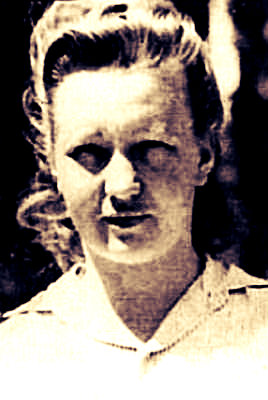
Binz took particular liking at making the lives of Red Army prisoners difficult. She even gave them a moniker calling them Russian swines. One survivor described her as being a sadist whose eyes shone when she was beating the hell out of people.
Doris Maase, a left-wing German doctor and one of Ravensbruck’s earliest residents, told of her first encounter with the sadistic female Nazi guard. According to her, it was when one of the inmates wanted to kill herself by throwing herself onto the camp’s electrical fence.
Binz stopped her, dragged her emaciated form and beat her with her cane on her naked thighs. To see such a display of cruelty from someone who was just young and attractive left a lasting impression in Maase’s mind.
Binz’s wont for cruelty soon became known throughout Ravensbruck. However, until she got the job there, there was no indication that such a violent nature could exist in her.
Dorothea Binz was the daughter of a forester and she grew up frolicking in the woods of nearby Furstenberg and like any other girls her age, attended the village school and church and swam in the nearby lake in summer or went skating on it during the winter.
Considerably, her work as one of the female Nazi guards at Ravensbruck was her first job. Apart from that, she was also young enough not to have that much experience about what life was like before the Nazis ruled Germany. Which was why it was easier for her to take the organization’s teachings and doctrines to heart. She was only ten years old when she, along with her friends, joined the League of German Girls, Hitler Youth’s female wing. She followed on with the Nazis’ curriculum in school. This said curriculum embedded in her the hate for Jews and to revile the outcasts of the society.
When she went down with tuberculosis, it made her miss out on school which left her with very few qualifications. Being branded as a TB carrier barred her from getting jobs as employers feared she would endanger other workers with the said disease. She worked as a kitchen maid before the opportunity of being counted as one of Hitler’s female Nazi guards presented itself. She literally jumped up at it when the offer was made. She was only nineteen at that time.
Rising up the work ladder, Binz laughingly recounted how her father tried to stop her from getting the job. However, the chance to live away from home, get good pay and live within cozy living quarters were too good to turn down. Furthermore, there also was the opportunity of meeting men. Soon, she found herself having an affair with a married SS officer.
Like all the female Nazi guards, Dorothea Binz was classified as just an SS auxiliary, a subordinate to the SS men. Not one of the female Nazi guards had official standing on paper. But, Binz was heavily absorbed with the SS mentality including the ideology that orders were very sacred and needed to be implemented accordingly, even the severest ones.
She took her responsibility as a female Nazi guard rather seriously and accepted that it was her responsibility, like the others, to protect the “homeland” from its internal enemies and that the fight inside the camp was as integral as the battle that was going on at WWII’s war fronts. As one friend described her the one time she went home for a visit. She said that Dorothea’s face had changed, that it looked harder and somehow wizened.
Dorothea Binz wasn’t alone in her cruel treatments to the prisoners.
There was 23-year-old, Maria Mandl, Langefeld’s replacement as chief of the female Nazi guards in the camp. Mandl’s amusement was finding curled hair during the prisoners’ roll call. She would let the women line up, walk through them very slowly looking to see which ones had curly locks peeking out from under their caps. if she did find what she was looking for, she would beat the owner of the curly lock of hair.
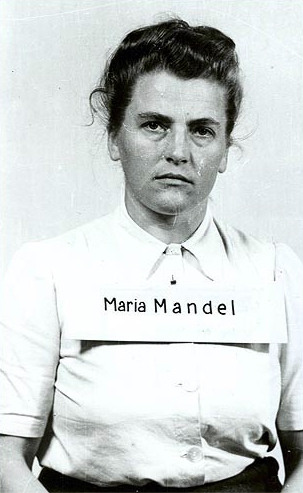
She would, then, send the offender away to be shaved and have her parade in front of the prisoners with a placard hanging from her neck saying – “I broke the rules and have curled my hair”.
Ravensbruck prisoners saw the female Nazi guards as two-faced. One time, Mandl beat up a Jewish women to death during roll-call for some offense. However, according to former Ravensbruck prisoner Maria Bielicka, a queer thing happened shortly after the beating. She recounted how one friend of hers had a cleaning job at the guards’ hostels where there was a piano. That time, she heard beautiful music coming out from the contraption and when she went to see who was playing, it was Maria Mandl, her fingers flying through the keyboard seemingly lost in a world of her own.
Eventually, Mandl was promoted and was sent to Auschwitz to become the concentration camp’s chief of the women’s section.
Dorothea Binz showed the same character as Marie Mandl. She had no qualms running after a leaving truck, which was filled with prisoners to be hanged, shouting “Wait for me. I want to come and watch”. But, when her precious dog, an Alsatian, died, she mourned and planted flowers on its grave. As one survivor put it, she found joy in beating people but loved a mere dog.
The female Nazi guards were not the only brutes in Ravensbruck, the camp’s hospital block had them, too.
Tall and blond Dr. Herta Oberheuser, who had a penchant for pink underwear worn under see-through blouses with gold bangles and rings adorning her arms and fingers, was one of them. She gave out lethal injections just because she felt like it even killing a teenager for simply wetting on the bed. When patients complained to her about feeling extremely thirsty, she would give them water but laced with vinegar.
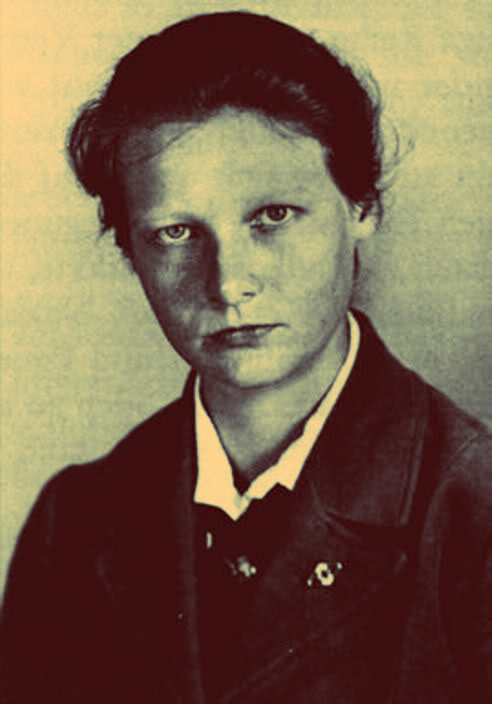
There was also the camp’s head nurse, Elisabeth Marschall. She had a chubby frame and a cheery face that lent her a maternal vibe. She could also be seen cuddling and cooing babies born inside the camp. However, behind her facade was a woman who stole great quantities of powdered milk, semolina and porridge from the parcels sent by the Red Cross for the same babies she cooed and cuddled. She kept these things for herself while the babies starved to death.
Elisabeth, like most of the staff, justified themselves with the reasoning that the prisoners were a burden to the Fatherland, therefore, they deserved the cruelty afforded to them. Binz had the same thinking as one time, she told her friend that the prisoners were godless criminals and prostitutes and treating them harshly was the only way to keep them in line.
Ruth Neudeck, one of the female Nazi guards who preferred to use her silver-handled riding crop on the prisoners, justified her actions by saying the residents of the Ravensbruck were ill-disciplined and she couldn’t hit them with her hands as they were infested with lice.
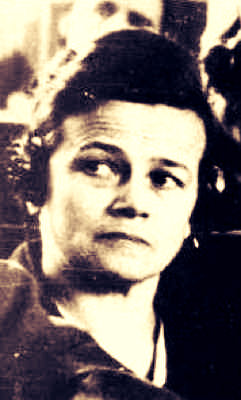
These shocking and revolting defenses on their actions were put forward two dozen of the worst offenders were put on trial and called on account of the war crimes they committed after WWII ended.
The crimes called out against them were so horrendous one prosecutor showed physical ill as he was reading through the evidences against the female Nazi guards. However, when Binz and the others were brought up on the dock to be tried, observers were struck at how ordinary they looked. As one writer cued in, “they [the female Nazi guards] could have stepped out of a bread queue in any German city”.
What sort of women had the gall to do such horrible things to those of their kind? Just the ordinary ones, women like you and me, who were given license to do evil.
What Happened to the Babies of Ravensbruck?
Some women who arrived in Ravensbruck in 1944 were heavily carrying babies int heir womb and gave birth the moment they arrived on the ground. Many others were on the early stages of gestation, frequently as a result of being raped by enemy soldiers. Most of these women were Poles who were rounded up and brought to the camp after the Warsaw Uprising.
Birthing inside the camp was banned and anyone who arrived pregnant went through an abortion. Nevertheless, during that time, there was simply too many women who needed to go through the procedure. So, a room was set up inside the camp’s hospital as a delivery room with a Czech prisoner doctor, Zdenka Nedvedova, and assisting midwives doing the deliveries.
At first, the babies and their mothers were treated well after the birthing. The mothers of the first twenty babies born inside the camp were given an extra glass of milk right mixed with oats right after the delivery.
However, it was only a matter of days when the extra rations were stopped. As a result, the new mothers’ breasts dried out and the babies starved to their deaths.
The orders were quite intentional and came directly from Heinrich Himmler’s SS, the ones who supervised the running of the Nazis’ concentration camps. They had no intention of allowing the babies to live and starvation was considered the most natural way to their deaths.
The mothers of these babies went almost mad. They were screaming and pleading for help. To remedy this, a new babies’ room, a Kinderzimmer as it was called, was put up. Here, the babies were brought after they were birthed and were laid out on two beds “like sardines”. Theyw ere placed head to toe with five one way and five on the other. A French prisoner, Marie-Jo Wilborts, was placed in charge of them.
Blankets were no longer available that inmates had to steal rags just to wrap around the babies. But the dreadful conditions took their toll against the young ones and in a month, the first one hundred of the babies born in camp and left this way were all dead.
In an interview with author Sarah Helms, Marie-Jo just gave out a sad smile when asked how she and the other baby nurses coped up during those times. She said that they just hoped some of the babies would survive.
Picking out an old ledger, smuggled from the camp, which recorded every birth and death in the Kinderzimmer, she showed the names of the babies born between September of 1944 until the camp got liberated, in April of 1945. Births numbered to 600. Of these, Marie-Jo stated, only forty survived. However, she added, most of the baby survivors were also taken to Belsen on February of 1945 and there, they, too, died.
